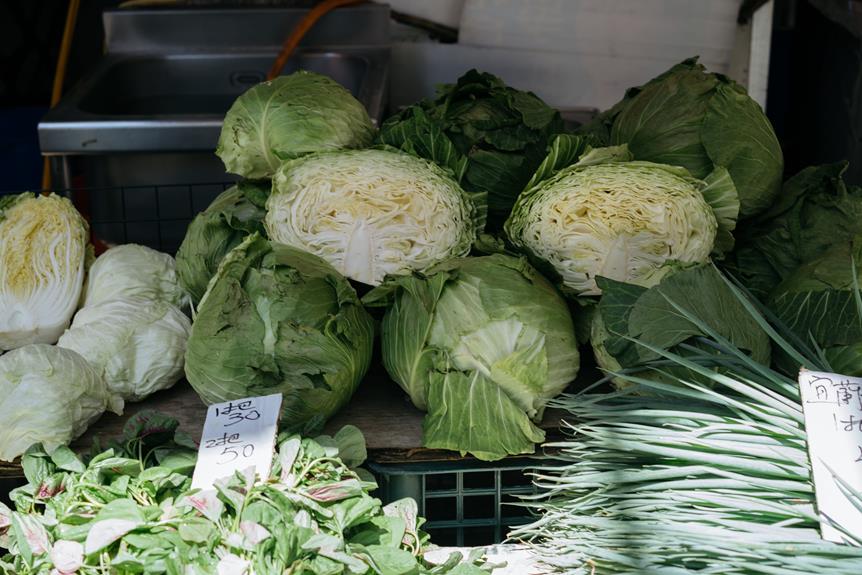Sustainable Living Made Easy with Urban Farming Techniques
Welcome to our guide on mastering urban farming techniques for sustainable living. Join us as we explore the benefits of urban farming, discover the right methods for your needs, and learn about essential tools and soil preparation techniques.
We’ll also show you how to maximize your space, conserve water, and effectively manage pests and diseases. Together, let’s embark on this journey towards a more self-sufficient and connected community.
Benefits of Urban Farming
One of the main benefits of urban farming is that it allows us to have direct access to fresh and nutritious produce. By growing our own fruits, vegetables, and herbs in our urban communities, we can ensure that our food is free from harmful pesticides and chemicals. This not only promotes better health for us and our families, but it also fosters a sense of community engagement.
Urban farming brings people together, as we can share our knowledge, resources, and harvests with our neighbors. Additionally, urban farming creates economic opportunities. By selling our surplus produce at local markets or starting small businesses, we can contribute to the local economy and generate income.
Choosing the Right Urban Farming Methods
When it comes to urban farming, we need to carefully consider the most suitable methods for our sustainable living goals. Here are three key methods to consider:
- Vertical farming: This method involves growing plants in vertically stacked layers, using limited space efficiently. Vertical farming maximizes yield and reduces the need for extensive land use. By utilizing vertical space, we can cultivate a wide range of crops in urban environments, contributing to food security.
- Hydroponic systems: Hydroponics is a soilless farming technique that relies on water and nutrient-rich solutions to grow plants. This method conserves water and eliminates the need for pesticides, making it an environmentally friendly choice. Hydroponics also facilitates faster growth and higher crop yields, ideal for urban farming.
- Container gardening: Container gardening is a versatile method that allows us to grow plants in various containers, such as pots, buckets, or raised beds. It’s accessible to beginners and can be easily adapted to small spaces. Container gardening offers flexibility and mobility, making it suitable for urban dwellers with limited outdoor areas.
Essential Tools for Urban Farming
When it comes to urban farming, having the right tools is essential for success. In this section, we’ll discuss the must-have tools that every urban farmer should have in their arsenal. We’ll also provide some valuable tips on how to properly maintain these tools to ensure their longevity and optimal performance.
Must-Have Urban Farming Tools
To effectively engage in urban farming, we rely on a range of essential tools that enable us to cultivate and maintain our urban gardens. These tools not only make our work easier but also help us maximize our yields in limited spaces.
Here are three must-have tools for urban farming:
- Vertical Gardening Systems: These innovative systems allow us to grow plants vertically, making the most efficient use of space. By utilizing vertical space, we can grow more plants in a smaller footprint, perfect for urban environments. These systems come in various designs, such as wall-mounted planters or stackable containers, providing flexibility in our garden layout.
- Hydroponic Systems: Hydroponics is a soilless method of growing plants that relies on nutrient-rich water. With hydroponic systems, we can grow plants faster and with less water compared to traditional soil-based methods. These systems typically include a reservoir, growing trays, nutrient solution, and a pump to circulate the water. Hydroponics is ideal for urban farming as it allows us to grow a wide variety of crops in limited space.
- Garden Tools Set: A comprehensive garden tools set is essential for any urban farmer. This includes a trowel, hand rake, pruning shears, gloves, and a watering can. These tools help us with tasks such as planting, weeding, pruning, and watering. Investing in good quality tools ensures durability and efficiency in our gardening endeavors.
Tool Maintenance Tips
We take great care in maintaining our essential urban farming tools to ensure their longevity and optimal performance. Proper tool maintenance is crucial for efficient and successful urban farming.
To keep your tools in top condition, it’s important to establish a system for tool organization. Designate a specific area for storing your tools and keep them clean and dry.
Regularly inspect your tools for any signs of damage or wear, and address any issues promptly. Sharpen blades regularly to ensure clean and precise cuts. Lubricate moving parts to prevent rust and keep them working smoothly.
Additionally, troubleshooting tips can help you quickly identify and resolve any issues with your tools.
Soil Preparation Techniques for Urban Farming
When it comes to preparing the soil for urban farming, there are two key techniques that can make a big difference: composting and raised beds.
Composting is essential for creating healthy soil by adding nutrients and improving its structure. This process involves collecting organic waste materials, such as food scraps and yard trimmings, and allowing them to decompose.
As the organic matter breaks down, it releases nutrients that enrich the soil. Compost also helps to improve the soil’s structure by enhancing its ability to retain water and nutrients, as well as promoting beneficial microbial activity. By incorporating compost into the soil, urban farmers can create a nutrient-rich environment that supports the growth and development of plants.
Raised beds, on the other hand, are a space-saving solution that allows you to control the quality of the soil and prevent contamination. These beds are typically built above the ground level and filled with a mixture of soil and compost.
By using raised beds, urban farmers can overcome challenges such as poor soil quality or limited space. The elevated nature of the beds provides better drainage and aeration, which can be particularly beneficial in urban environments where the soil may be compacted or contaminated.
Additionally, by filling the raised beds with a mixture of high-quality soil and compost, farmers can ensure that their plants have access to the necessary nutrients for healthy growth.
Composting for Healthy Soil
One essential technique for preparing healthy soil in urban farming is the practice of composting. Composting is a natural process that converts organic waste into nutrient-rich soil amendment. By recycling kitchen scraps, yard trimmings, and other organic materials, we can create compost that enriches the soil and promotes plant growth.
Here are three composting techniques for effective organic waste management:
- Backyard composting: This method involves creating a compost pile or using a compost bin in your backyard. It requires mixing green (nitrogen-rich) and brown (carbon-rich) materials, regularly turning the pile, and maintaining proper moisture levels.
- Vermicomposting: This technique uses worms to break down organic waste. A worm bin is set up, and the worms consume the waste, turning it into nutrient-rich castings. Vermicomposting is ideal for small spaces and is a great way to recycle kitchen scraps.
- Community composting: This approach involves setting up a communal composting system where neighbors or community members can contribute their organic waste. It promotes collaboration, reduces individual efforts, and fosters a sense of belonging within the community.
Raised Beds for Space-Saving
To maximize limited space in urban farming, we can utilize raised beds as a space-saving soil preparation technique. Raised beds are essentially small, elevated garden plots that are filled with soil and used for planting crops. They’re an excellent solution for urban farmers who’ve limited space but still want to grow their own food.
One of the main advantages of raised beds is that they allow for better control over soil quality and drainage. Additionally, they provide a compact and organized way to grow plants, making it easier to manage and maintain the garden. Raised beds can also be used for vertical gardening, where plants are grown upwards on trellises or stakes, further maximizing space.
Maximizing Space for Urban Farming
In our quest for sustainable living, we can maximize space for urban farming by utilizing innovative techniques and strategic placement of crops. Here are three ways to make the most of limited space:
- Vertical Gardening: By growing plants vertically, we can save valuable ground space. Install trellises, hanging baskets, or wall-mounted planters to grow crops such as tomatoes, cucumbers, and herbs. This method not only saves space but also adds visual interest to your urban farm.
- Hydroponic Systems: Hydroponics is a soilless growing method that allows plants to thrive in nutrient-rich water. This technique requires less space and can be done indoors or on rooftops. Invest in a hydroponic system that suits your needs and grow a wide variety of vegetables, fruits, and herbs.
- Companion Planting: Maximize every inch of your urban farm by practicing companion planting. Choose crops that complement each other in terms of growth habits, nutrient needs, and pest control. For example, grow tall plants like corn alongside climbing beans to utilize vertical space while providing shade for smaller plants like lettuce.
Water Conservation in Urban Farming
After maximizing space for urban farming, our next focus is on water conservation techniques in order to maintain sustainability.
One effective method is rainwater harvesting, which involves collecting and storing rainwater for later use. Installing rain barrels or cisterns can help capture rainwater from rooftops, which can then be used to irrigate crops. This not only reduces reliance on municipal water sources but also helps prevent runoff and erosion.
Another important aspect of water conservation in urban farming is efficient irrigation. Drip irrigation systems or soaker hoses can deliver water directly to the plant roots, minimizing evaporation and water waste. Additionally, regular maintenance and monitoring of irrigation systems can prevent leaks and ensure optimal water usage.
Pest and Disease Management in Urban Farming
One crucial aspect of urban farming is effectively managing pests and diseases, ensuring the health and productivity of our crops. Here are three key strategies for organic pest control and natural disease prevention:
- Crop rotation: By rotating the types of crops planted in different areas of your urban farm, you can disrupt pest life cycles and reduce the risk of diseases spreading. This technique also helps replenish soil nutrients and maintain overall soil health.
- Companion planting: Certain plants have natural abilities to repel pests or attract beneficial insects. By strategically interplanting these companion plants, you can create a natural barrier against pests and promote a balanced ecosystem in your urban farm.
- Integrated pest management (IPM): IPM involves using a combination of techniques, such as physical barriers, biological controls, and targeted pesticide applications, to manage pests. It focuses on minimizing harm to the environment while effectively controlling pest populations.
Conclusion
Mastering urban farming techniques is the key to sustainable living in our concrete jungles. By choosing the right methods, using essential tools, and preparing the soil properly, we can create lush green spaces even in the smallest of urban areas.
With efficient water conservation techniques and effective pest management, our urban farms will thrive, providing us with fresh, organic produce. So let’s roll up our sleeves, get our hands dirty, and transform our cities into thriving gardens of abundance!







2 Comments
Comments are closed.